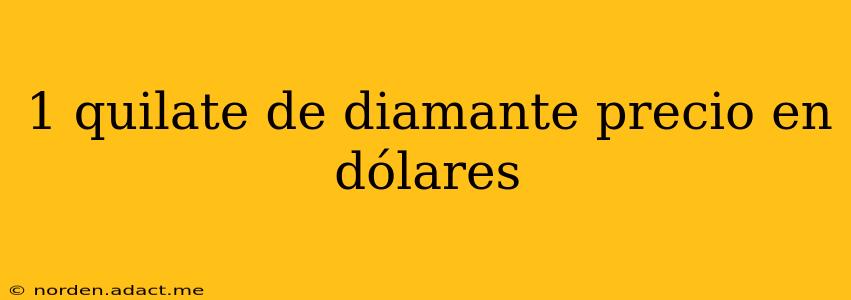1 Carat Diamond Price in US Dollars: A Comprehensive Guide
The price of a 1-carat diamond in US dollars is highly variable and depends on several key factors. There's no single answer to this question, as the cost can range from a few thousand dollars to tens of thousands. Understanding these factors is crucial for making an informed purchase.
This guide will delve into the intricacies of 1-carat diamond pricing, answering frequently asked questions and providing valuable insights to help you navigate this complex market.
What are the 4Cs of Diamond Grading?
The price of a diamond is primarily determined by the "4Cs": Cut, Clarity, Color, and Carat weight. Let's examine each in detail:
-
Cut: This refers to how well a diamond's facets interact with light. An excellent cut maximizes brilliance, fire, and scintillation, resulting in a more dazzling and expensive diamond. Poorly cut diamonds appear dull and lifeless, even if they have high color and clarity grades.
-
Clarity: This refers to the presence of inclusions (internal flaws) and blemishes (external flaws) in the diamond. Flawless diamonds are extremely rare and command the highest prices. Diamonds with fewer and less noticeable inclusions are generally more expensive.
-
Color: Diamonds are graded on a scale from D (colorless) to Z (light yellow or brown). Colorless diamonds are the most valuable, with slight color variations impacting price significantly. The lower the color grade (closer to D), the higher the price.
-
Carat Weight: This refers to the diamond's weight, with one carat equaling 200 milligrams. While a 1-carat diamond is a popular size, the price per carat typically increases as the size increases due to rarity. However, a 1-carat diamond with exceptional cut, color, and clarity can be more expensive than a larger diamond with lower grades.
What factors besides the 4Cs affect the price of a 1-carat diamond?
Beyond the 4Cs, several other factors influence the price of a 1-carat diamond:
-
Brand: Reputable diamond brands often command higher prices due to their reputation, certifications, and marketing.
-
Retailer: Different retailers have different pricing structures and markups. Some may offer better deals than others.
-
Shape: The shape of the diamond (round, princess, emerald, etc.) also impacts its price, with round brilliant diamonds generally being the most expensive.
How much does a 1-carat diamond typically cost?
As mentioned, there's no single answer. A 1-carat diamond with excellent cut, color (D-F), and clarity (IF-VVS) could cost tens of thousands of dollars. Conversely, a 1-carat diamond with lower grades (e.g., I color, SI1 clarity) might cost significantly less. You can expect a price range from several thousand dollars to upwards of $15,000 or more, depending on the specific diamond's characteristics and where you purchase it.
Where can I find information about the price of a 1-carat diamond?
Several online resources provide diamond price estimates based on the 4Cs. However, it's crucial to remember these are estimates and the actual price may vary. Visiting reputable jewelers and comparing prices is crucial before making a purchase.
Are there different types of 1-carat diamonds?
Yes, absolutely! The vast difference in price comes from the variations in the 4Cs. A 1-carat diamond with perfect clarity and color will be far more expensive than one with visible inclusions and a noticeable tint. Also, the diamond's cut significantly influences its brilliance and overall appearance, directly affecting its value.
Can I negotiate the price of a 1-carat diamond?
Negotiating the price of a diamond is possible, particularly when purchasing from private sellers or smaller jewelers. Researching prices beforehand and being knowledgeable about the 4Cs will strengthen your negotiating position.
By carefully considering the 4Cs and other factors discussed above, you can make a more informed decision when purchasing a 1-carat diamond. Remember to do your research, compare prices, and consult with reputable jewelers to find the perfect diamond within your budget.
